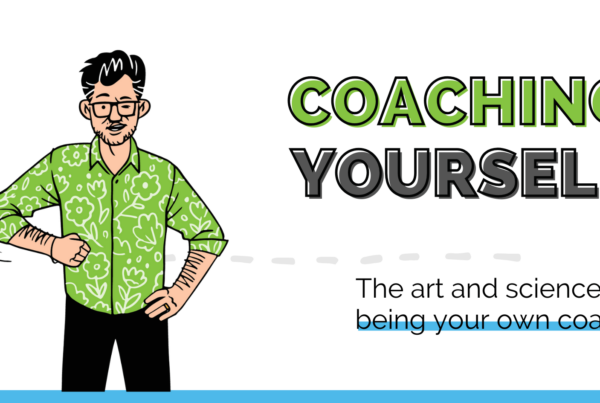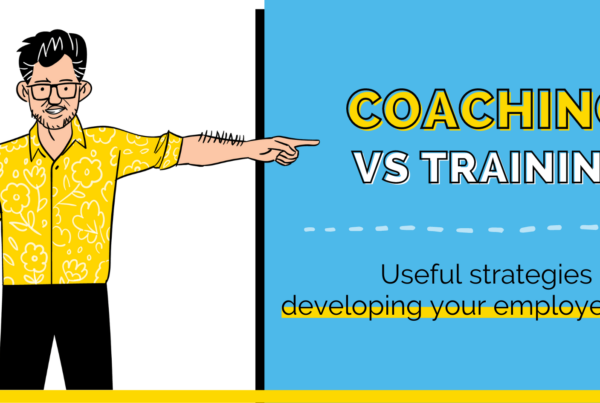
One of the most influential articles I’ve ever read is by a guy called Daniel Goleman, who you may know for popularizing the idea of emotional intelligence.
Based on the research in his article for the Harvard Business Review, Goleman found that six different leadership styles tended to show up in organizations: Commanding, Pace-setting, Visionary, Coaching, Affiliative, and Democratic.
One of the key findings was that a great leader knows how to use all six of those leadership styles at the appropriate time, while average leaders used one, two, or perhaps three styles, and that was all.
They found that coaching was the least utilized of all of the leadership approaches, even though it had a hugely positive impact on employee engagement, culture, and the bottom line.
Now, that was 23 years ago. Has anything changed? I’m going to say probably not a whole lot. Despite the growing buzz around it, coaching is still a massively underutilized approach to leadership and management.
Let me explain why.
The Greatest Answers Come From the Greatest Questions
Become a better leader. Better teacher. Better person.
Learn how to ask the right questions the right way with this free download.
Eight Ways to Ask a Question Well
The Barriers to Embracing the Coaching Leadership Style
As a leadership style, what coaching brings is a commitment to unlocking people’s potential, focusing on the stuff that matters, empowering others, and helping them take responsibility.
Sounds great, right? So, why isn’t this happening all that often? In my experience working with countless organizations, there are several obstructive factors:
The first is that organizations tend to emphasize doing rather than thinking. There’s this sense that it’s all about go, go, go. It’s all about busy, busy, busy. In a culture like that, it’s troubling when you see people just sitting there staring into space. A part of you would think: “What are they doing? What’s that about?”
All this emphasis on doing means leaders become hardwired to leap into action. But coaching challenges this mindset because it’s all about slowing down the rush to instruct, advise, and act. It’s about creating a little more curiosity, which can feel counterintuitive when you’re so used to relentless doing.
The second is a lack of time – or rather a perceived lack of time. Most leaders believe that coaching needs to be its own formal, time-consuming event. On the contrary, you can have an effective coaching conversation in 10 minutes or less. All you need (as you’ll find out in just a minute) is a good set of questions and a willingness to tame your inner advice monster.
The third relates to understanding the difference between expertise and curiosity. As we become more senior, learned, and experienced in the work that we do, we become invested in our sense of expertise. We feel like we need to give advice to add value.
Shifting from sharing that expertise to using that expertise to fuel your curiosity is one of those simple-sounding behavior changes that are actually quite tricky. There is a seduction to giving advice that leaders must be mindful of if they want to communicate better.
5 Key Skills for Coaching Leaders
Although there are several barriers to embracing the coaching leadership style, each of them is surmountable. And the benefits of coaching are too juicy and game-changing to not surmount those barriers.
After all, by building the coaching strand of leadership within you, you’ll drive engagement, boost bottom-line profit, and help your workforce become more effective, innovative, and motivated.
So, here are the key skills you need to become more coach-like as a leader:
1. Lean Into Curiosity
Embracing coaching as a leadership skill is a lot simpler than you think. It’s about doing less, not more.
How? By embracing curiosity.
Instead of leaping in with advice, opinions, and solutions, try to slow down that rush to interject. I’m not saying to never give advice. Rather, consider that the time and place for advice is almost always later than you think.
Powerful questions are the rocket fuel of curiosity. In my book, The Coaching Habit, I discuss the seven essential ones you need to be a great leader. They go a little something like this:
- “What’s on your mind?”
- “And what else?”
- “What’s the real challenge here for you?”
- “What do you (really) want (from me)?”
- “How can I help?”
- “If you’re saying yes to this, what are you saying no to?”
- “What was most useful for you?”
2. Get Comfortable With Silence
In the moments after you ask a question, you’re going to be met with (possibly awkward) silence.
So, the next coaching skill to learn is to be quiet. Don’t let your discomfort with a heartbeat or two of awkwardness get in the way of them having the space to think about and answer the question. Ask, then wait patiently as they try to figure out the answer.
Although it will feel strange and slightly uncomfortable, what’s happening is that the person you asked the question to is forming new neural pathways in their brain. That silence is the sound of them growing, learning, and becoming more confident. So, be generous with it.
3. Tame Your Advice Monster
As you start to embrace curiosity, you’re going to be met with a form of internal resistance. That’s your advice monster. We all have one. It’s the little voice in your head that loves to give their two cents to any and every problem that comes its way.
You know how it goes. Someone starts to share a problem with you and, almost instantly, your advice monster tries to sabotage the conversation, desperate to impart its wisdom. If this sounds all too familiar, my book The Advice Trap offers helpful strategies to help you start taming that monster.
Now, you might be thinking, “Sure, other people’s advice monsters can be annoying, but my advice is pretty good!” And, in fairness, advice-giving isn’t bad in and of itself. However, trouble arises when giving advice becomes your default way of engaging with others.
That’s because your advice is rarely as good as you think it is. And, more importantly from a leadership standpoint, giving advice demotivates and disempowers the receiver.
As Edgar Schein wisely put it in his book, The Humble Enquiry, advice-giving ‘one ups’ you and ‘one downs’ the other person. If you’re not careful, your people will end up feeling withdrawn, demotivated, and completely dependent on you.
Thankfully, curiosity and generous listening directly counteract the advice monster. So, remember – slow down the rush to advice, ask more questions, and stay curious just a little longer.
4. Empower Your Team by Doing Less
A huge aspect of the coaching leadership style is learning to be lazy. It sounds provocative, I know, but it essentially boils down to this – stop doing the work for your people and let them do it for themselves.
Instead of taking full responsibility for everyone and becoming stressed by trying to keep everything under control, learn to be generous with autonomy, trust, and freedom.
You see, you don’t have to be an expert in everything your people do. Your job as a leader is to set the playing field and facilitate progress by ensuring the right tasks land with the right people.
To make this happen, I recommend having what I call The Keystone Conversation – the central concept in my latest book, How to Work With (Almost) Anyone – which teaches you how to build thriving workplace relationships.
The Keystone Conversation is essentially a social contract; a discussion based on seven questions in which you get to understand the person you are leading: their past experiences, patterns, preferences, and so on.
By getting to truly know the authentic humans you are working with, you can lead in a way that inspires and motivates them.
5. Be Often
One of my most slyly radical principles for coaching employees is to ‘be often’. By that, I’m blowing up the idea that coaching is an occasional, hierarchical, formal event. The crux is that every interaction you have can be more coach-like.
Whether you’re talking on Microsoft Teams, by the water cooler, on the phone, or over lunch, you can weave coaching into any conversation you have. All you need is a dash of curiosity and a steadfast commitment to taming your advice monster.
So, get it out of your head that you need anything more than 10 minutes to coach, that you need to wait for the right time to coach, or that you need to book a meeting to coach. Anytime you’re speaking with someone is a chance to stay curious a little longer and slow down that rush to give advice.
Unlock Greatness. Yours. Theirs.
Every leader can and should strive to be more coach-like. It’s a surefire way to have a greater impact, do more stuff that matters, and build a high-performing, effective team.
If you’d like more strategies to unleash your curiosity, check out my book, The Coaching Habit.




